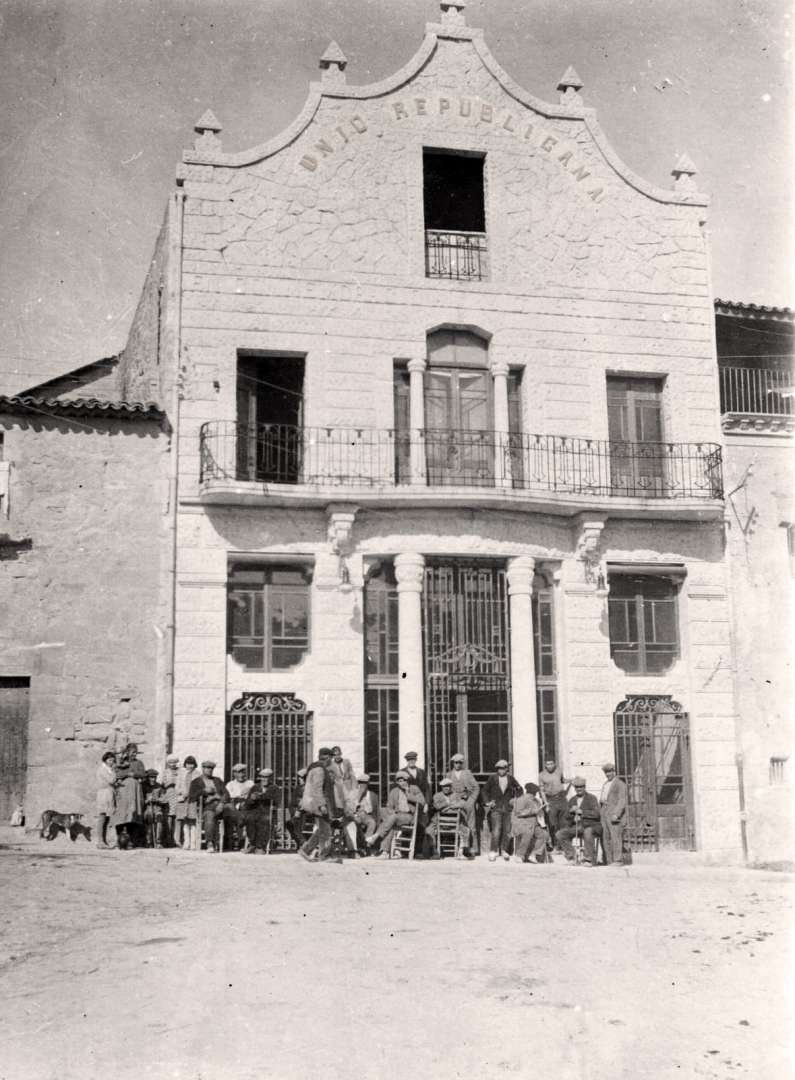Antiga seu d'unió republicana - English
THE FORMER REPUBLICAN UNION CENTRE

Construction began on the former Republican Union Centre in 1913, where the Town Hall is currently located. The following year it was put into operation and inaugurated by representative Joan Moles. The facades are modernist in style, designed and built by the master builder Sisquet del Sumalla. The main facade, which dates to 1931, commemorates the proclamation of the Republic and was inaugurated in 1932 by the President of the Government of Catalonia Francesc Macià in a massive event.
The creation of this political, cultural, and recreational society and the construction of this structure arose from different demands for social improvements in the Catalan countryside after the events of July 1909, when there was a strong revolutionary movement in Arbeca following the burning of the train in La Floresta and the subsequent repression. During the construction of the building, the members of this progressive and republican society met in the Cafè del Menso, located in the Plaça Major.
This Centre, of which most of the families in the town formed part, became a space for meeting and sharing progressive ideas, representing a point of reference for people who wanted a change to the conservative structures of the time. The members of the Independent Centre, with conservative ideas, called the Republican Union "la Rampinya" (the den of thieves) because they believed that the group fostered a collectivist ideology.
Over the years, the centre organized many cultural activities, conferences, and debates on social and political issues, as well as recreational and sports activities to promote civil life in the town. It was also home to a school for boys, with teachers funded by the entity and by the students themselves. Every Sunday, on the esplanade in front of the premises, now the Plaça Generalitat, free film sessions were offered and the news could be heard on the radio that was installed shortly after the construction of the building. Local artists and art fans held different theatrical performances from time to time and a group of local musicians livened up the dance sessions at all festivals.
After the proclamation of the Second Republic, and especially after the outbreak of the Spanish Civil War (1936-1939), some more radical sectors such as the CNT-FAI opened other social offices. The headquarters of the Republicans became a highly politicized space and was put to the service of the Republican cause, becoming the scene for many meetings and assemblies that were held there.
When Franco's army entered Catalonia and reached the gates of the Segre river, Arbeca's proximity to the front turned the building's offices into a bloody hospital. As it was a field hospital, the flow of wounded soldiers arriving there was continuous. Those who did not survive were buried in a mass grave near the old cemetery. Many girls in the village volunteered as nurses and many young people who were not on the front lines helped out as stretcher bearers transporting the wounded.
With the entry of the Franco's army in January 1939, the building was confiscated by the Falange and all the Republican emblems of the building were demolished and removed from the interior and exterior facades. Its facilities became the offices of the Falange, the Youth Front, and the Women's Section, which carried out military training and fascist indoctrination activities for young people and adolescents.
During the dictatorship, the memory of this space was silenced and forgotten until the democratic restoration. The building was mostly destroyed by snowfall in 1944 and later, and a large part of it was practically useless. In 1948, with the building in poor condition, the Court of First Instance of Les Borges Blanques granted ownership of the property to former creditors of the entity, who put it up for sale in 1949. It was then acquired by a family from La Floresta, who intended to demolish the building to make homes. Finally, the City Council of Arbeca was able to buy it and moved the municipal offices there in 1961, which had previously been located in the old hospital.
Between 1984 and 1985, the entire building was remodelled, preserving the facades. The main office of the City Council, the municipal offices, and the library were built, which were accessed through the main facade of the street, and the back was used for other municipal facilities that have been modified according to needs. Several maintenance, improvement, and renovation works have been carried out to promote accessibility in the present day.
